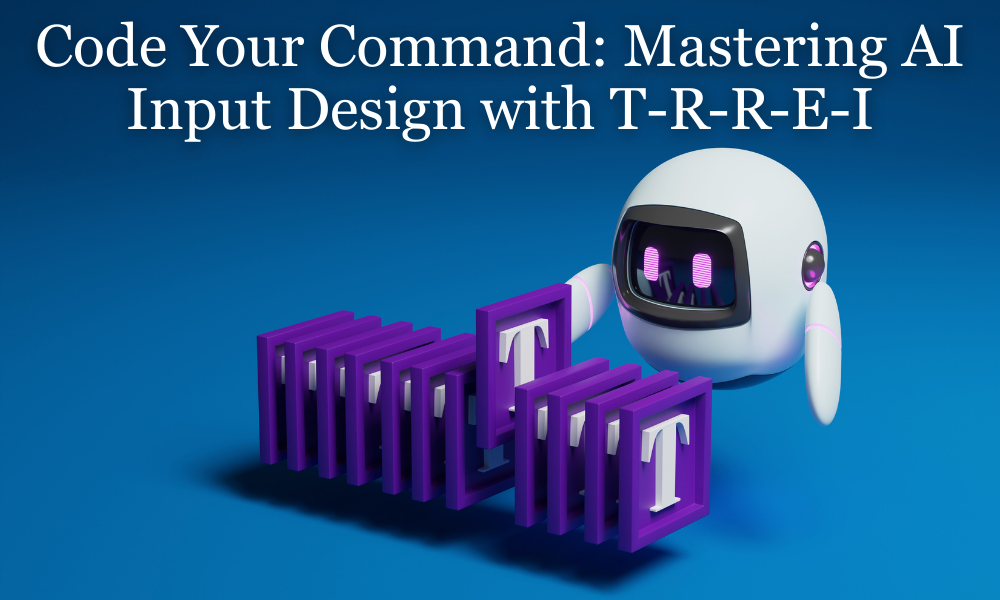Code Your Command: Mastering AI Input Design with T-R-R-E-I
How to design AI input requests that provide is true.
Remember to offer truly smart but excessive internships – the more you explain the task, the better the results will be.
This is your gamebook for designing practical and interesting input requests with frameworks, mnemonics, examples.

The core of the 5-stage prompt framework is a simple framework:
T-R-R-E-I → Task, Context, Reference, Evaluation, isothere
Tasks – What do you want?
“Please suggest an anime gift for your friend’s birthday.”
Context – Show details.
“She’s now 29 years old and loves levelling Naruto and solo.”
Reference – Support for example.
“Last year, she loved Itachi Funko Pop.”
Ratings – Check the output. Is that enough?
interferon-Refine to happiness.
Pro Tip → Persona + Format added.
Persona: “Act as an anime expert.”
Format: “Show proposals in tables with prices, categories, and anime series.”
MNEMONICS from the course: Always Ittery.
My Personal Edition: Small Crabs Drive Giant Iguanas (easy to remember). Or cool robots eat ice.
How to fix bad input requests (iterative method)
AI may still spit out “Meh” results. It’s not panic. Use these four fixes:
Revisit Framework – add context, examples, or people.
short sätze-dont word-vomit. We will supply AI in stages.
Analog Tasks – If marketing copying is boring, ask them to write a story instead.
Limitations – Closer Focus: “Only 90s – Rock – under
minutes.”
MNEMONICS → Ramen saves tragic idiots
Daily work superpower
AI is the productivity buddy of daily tasks:
e -Mails:
” Curious friends. ”
Brainstorming:
” Tell us five icebreakers’ ideas for remote team start grouped by Fun vs Professional. ”
💡Pro tips → Save the best with input requests (terms/Google docs)
📊Data and Presentations (AI + Spreadsheets)
Data Analysis:
“This is a Google Sheet with Memory Data. Create a column where the average sales per customer is calculated.”
“Give insight into the number of customers compared to sales trends.”
Foil:
“Designing a 6-slide pitch deck for an environmentally conscious gene Z-audience.”
Here, don’t imagine AI as your junior analyst and design designer – not as the ultimate boss.

Advanced Request: Thinking like AI, here’s fun.
First Chain
Small Tasks Breaking Small Tasks:
You sum up your novel.
Ki Thinking Chain
Ask Ki to explain your argument:
“Solve it with each of this step. Explain your thought process.”
Denk Tree
Explore several options at the same time.
“Imagine three designers, brainstorming. Everyone writes steps, shares them, and moves forward.”
Combo Tips → Mix Denk Baum + Shood Chain to make it as clear as possible.
AI Agent: Your Personal Expert
AI Agent = Steroid Role Play Mode.
Two killer types:
Simulation Agent (Agent SIM) Ideal for training.
“Do you act as an interviewer? Stop saying “jazz hand” and give us feedback.
Expert Feedback Agent (Agent X)
Ideal for criticism.
“Act as a luxury car VP. Criticize the campaign pitch and summarise the improvements until you say “break.”
Agent Design Method:
Give him a persona.
Already context.
Define interactions. Add astopphrase.
Ask for feedback.
Results = Instant Tutor, Coach, or Consultant in Pocket.
Prejudice: Data training data from humans = human prejudice.
Rule of thumb: Loop man. Be sure to check the cost before using it.
Fast Self-Inspection (Quiz Time!)
What does T-R-R-E-I represent?
Calls two iteration methods.
A series of thoughts to thoughts → What is the difference?
How do you design your Fitness Coaching AI Agent?
(head answer or comments below – active recall = better memory!)
Conclusion
Good input requests are not due to clever hacking. They are about clarity, context, and repetition.
If you remember nothing else:
AI treats AI like an intelligent intern → Give him roles, examples, feedback until he nails his work.
This way you will not only enter the pie for the copy, but also actually design it.
Chain of thinking about ideas → What is the difference?
How do you design your Fitness Coaching AI Agent?
(head answer or comments below – active recall = better memory!)
Good input requests are not due to clever hacking. They are about clarity, context, and repetition.
If you remember nothing else:
AI treats AI like an intelligent intern → Give him roles, examples, feedback until he nails his work.
This way you will not only enter the pie for the copy, but also actually design it.







